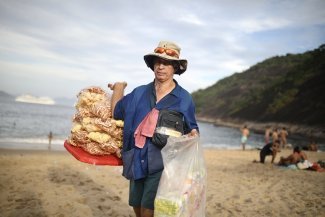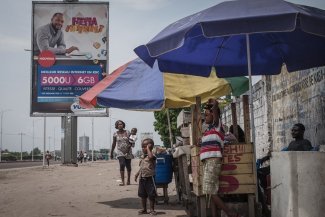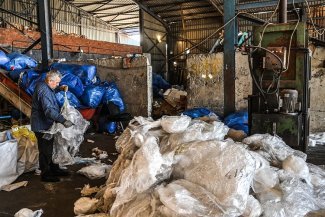
A technician casts a net to test the quality of the shrimps growing at Green Farm, in Soc Trang, in the Mekong Delta.
At a glance, Green Farm looks like any other shrimp farm. The 35-hectare facility is divided up into 46 ponds, between 1 and 1.5 metres deep, aerated by turbines that run around the clock. The shrimps are separated by species and size and some of the ponds are left empty whilst they are cleaned.
The shrimps at Green Farm do not, however, grow in the same way as those in most of the farms dotted across the Mekong Delta, in the south of Vietnam. At Green Farm, antibiotics cannot be used, the waste water cannot be released without being treated, and the company has to trace the origin of the raw materials used in the feed given to the shrimps, along with a wide range of other standards that have to be met for sustainable certification by the Aquaculture Stewardship Council (ASC). The company was ASC certified in September 2016.
The requirements are strict and the costs higher, but certification had become crucial to the survival of Stapimex, the company that owns Green Farm, in a sector hard hit by the changes in climate patterns in the region, as well as the pollution that has built up over the decades due to the excesses of various industries. “We wanted a business that was sustainable in the long term,” explains Nguyen Dang Khoa, quality manager at the company. “You can also earn more by investing more money,” he says.
Since it came into being, the Mekong River has been depositing the sediments collected over its 4000-kilometre journey at its mouth, making the delta one of the most fertile and biodiversity-rich regions in the world. Conscious of this wealth, the Vietnamese have concentrated a large share of their national production in the region, which is home to 50 per cent of its rice production and 70 per cent of its aquaculture, for example, and accounts for a third of GDP, according to World Bank figures. Over 18 million people, a fifth of the country’s population, live in between the many branches into which the Mekong divides.
Following the economic reforms launched in 1986, production in the agriculture, livestock and aquaculture sectors was intensified, and the pesticides, fertilizers and waste from the farms ended up in the waters of the Mekong, along with the household waste.
“Most of the pollution in the delta comes from agriculture and the cities,” says Huynh Quoc Tinh, an aquaculture project manager for WWF Vietnam. The region is also one of the most vulnerable in the world to climate change.
According to a WWF report from 2009, the effects of climate change could already be felt back then, with higher average temperatures, more intense and devastating rains, and more frequent extreme climatic events, as well as increased salinization due to seawater intrusion.
In addition, unbridled development has left its mark on the delta and is threatening the very survival of the region. The high concentration of shrimp farms has led to outbreaks of disease and high death rates among the species, whilst the dams being built by the neighbouring countries, through which the Mekong also flows, especially Laos and China, are affecting the amount of sediment and, in turn, the nutrients in the soil.
Last year, the weather phenomenon El Niño caused the worst drought in the Mekong Delta in almost a century, increasing salinity and affecting 400,000 hectares of crops due to the loss of fertility. Over 25,000 hectares of this land could no longer be worked.
Green Farm is not alone in its battle against the effects of this intensive development in the Mekong Delta. Increasing numbers of companies are trying to obtain sustainable certification or improve their practices. “The fact that some companies are adopting sustainable standards is also affecting non-certified farms, which are following their example,” says Tinh of the WWF.
Stapimex itself buys non-certified shrimps from small producers in the area to supply its processing factories. According to the company’s quality manager, these suppliers began improving their practices following the launch of Green Farm.
Another industry that is undergoing rapid reform, after being criticised for its high environmental impact, is that producing the controversial pangasius, a white, delicately flavoured fish that became popular in Europe in the 2000s.
High demand for the fish led to the proliferation of pangasius farms, to supply its main global exporter.
“The industry and the authorities have realised, over recent years, the impact of fish farms on the environment and the quality of the water,” explains To Thi Tuong Lan, vice secretary of the Viet Nam Association of Seafood Exporters and Producers, VASEP. “That’s why we have kept the production of pangasius to 1.2 or 1.3 million tonnes, so that we can focus on the quality of the fish and the sustainable development of the industry.”
Inclusive water management
During the 1990s, the quiet village of Vam Nao, set on the bank of the river from which it takes its name, underwent a radical change. Until then, the river, a branch of the Mekong, had allowed the local community to have two rice harvests a year, just enough for it to survive on, but not enough to provide food for all the villagers. But the river also supplied another basic source of nutrition, fish. As part of its policy to increase the delta’s agricultural productivity, the government funded a new irrigation system in Vam Nao, which allowed the villagers to increase their annual harvests to three, and to grow vegetables.
The pesticides, however, polluted the land and the water, and the amount of fish was drastically reduced, by as much as 90 per cent between the 1990s and 2013, according to the figures of the Center for Water Resources Conservation and Development (WARECOD). In addition, the use of dykes, required to flood the paddy fields, affected migration cycles. “It was obstructing the migration of fish that journey up river to spawn and then return to the delta,” explains Vu Hai Linh, a researcher for WARECOD.
Given the scarcity of the resources, disputes over water use became increasingly frequent between the different communities, and the high level of centralisation in the country meant that decisions were delayed by weeks or months, pending a response from the authorities. After years of frustration, the government began giving the communities greater powers as of the year 2000, with the Participatory Irrigation Systems.
“Now the local communities are working together and are no longer passively subjected to the local authorities,” says Linh.
In addition, the villagers released 20 tonnes of fish to rebuild native fish stocks, and the farmers received advice on sustainable agricultural and livestock production practices.
Linh explains that similar approaches are starting to spread across the region and could be one of the keys to more sustainable development in the delta. “Now [the communities] have more channels through which they can make their voice heard during decision-making processes,” says the researcher. “This is essential, because the local communities have a long history and an in-depth knowledge of their own river and irrigation management.”









